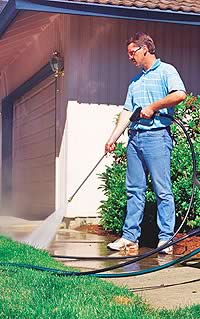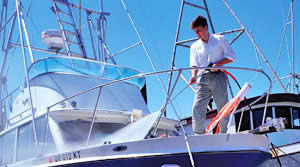
Pressure Washers for the Pro
The first questions you should ask yourself when looking at pressure washers are: How much pressure do you need? What are you taking off your surface? And how hard is that surface?
by John Strieder
contractor Ron Franklin went shopping for pressure washers five years ago, he craved two things — a hot chassis and a big engine.
He spent close to $4,000 on a Simpson belt-drive unit with a 20-horsepower V-twin Honda motor that cranks out 4,000 psi. It’s a little heavier than what most contractors use, he says, but it’s worth it.
“The main thing is, I like to have more power,” he says. “The more psi the better.”
It’s a looker too, raves the self-proclaimed tool buff. “The tools have to work good, but they have to look good too. This is a beautiful machine. It even has little mag wheels!”
A nice-looking piece of equipment has its benefits on-site, he says. It’s easier to justify rates to a customer if a good-looking machine is sitting in the back of the truck.
With more spray pressure, he can move the wand faster and widen his spray angle without losing effectiveness, he says.
Perhaps most importantly, his machine has a throttle that allows him to adjust the pressure to suit the situation. “You cover all your bases,” he says.
The first questions you should ask yourself when looking at pressure washers are: How much pressure do you need? What are you taking off your surface? And how hard is that surface?
Too much pressure can damage the surface you are cleaning or stripping. Anything greater than 2,000 psi can cut into wood, says Pat White, customer service manager for MI-T-M Corp.
On the other hand, lower pressure means the job takes longer. “You only want to go as high as you need to go to get something accomplished,” says Jon Knutson, who markets contractor equipment for Graco Inc.
Another key element to pressure washing is knowing when to lay off the pressure and go with the flow.
Peeling gum off a sidewalk requires pressure. But volume, measured in gallons per minute, is what gives a pressure washer the power to clean.
“Most people look at pressure washers and say, give me all the pressure I can get,” says Crismon Lewis, marketing manager for C-Tech Industries Inc.’s Shark pressure washers. “Gallons per minute is what really cleans.”
Pressure washers are not complicated machines, but they come with a number of options.
Hot water pressure washers clean faster, says Lewis, and are especially effective on oil, soot and grease. But they are also more expensive, he says, and hot water is not used much in paint jobs. “Typically, contractors are going to go without it if they don’t need it.”
 Hot water machines typically do not produce psi rates as high as their cold-water cousins, White adds. Hot water machines typically do not produce psi rates as high as their cold-water cousins, White adds.
Then there is the question of belt vs. direct drive. Belt-drive machines work their pumps less and absorb vibration better than direct-drive models. “In essence, there’s more pump life to the belt drive,” White says.
Belt-drive units are also heavier, more expensive and more complex. But Lewis recommends that if you plan to use your pressure washer more than 20 hours a week, spring for the belt drive.
Another important option to look for is an unloader, a component that loops water back through the machine when it’s not emitting spray. The part features a pressure adjustment knob.
The pumps in most heavy-duty pressure washers have ceramic plungers. Models intended for lighter applications may have coated steel plungers or radial axial pumps.
most commercial-use pressure washers are fueled by gasoline. Electric pressure washers are quiet, fuel efficient, and don’t expose the user to carbon monoxide poisoning, says Richard Kurtz, president of Water Cannon Inc.
But in terms of power, they’re very limited, because standard household current is limited to 115 volts. “Our most powerful household-current model is 1,800 psi,” Kurtz says. “For most contractor uses that’s not enough. I would suspect the contractor industry would continue to purchase gas-powered models.”
Can contractors avoid sweating the details by simply shopping for a contractor-grade machine? Not necessarily, Kurtz says. “Looking for contractor grade by itself doesn’t work,” he says.
One sure bet, he says, is to avoid buying pressure washers at box stores such as Sam’s or Home Depot. Instead, shop with professional distributor<title>Pressure Washers for the Pro - PaintPRO Magazine</title>
<meta name="keywords" content="pressure washers">
<meta name="description" content="Pressure Washers for the Pro. The first questions you should ask yourself when looking at pressure washers are: How much pressure do you need? What are you taking off your surface? And how hard is that surface?">s, or from a manufacturer that distributes “continuous-duty” products intended for daily use.
Pressure washers come with four different tip sizes, identified by the size of the angle at which they spray water.
The smallest, 0 degrees, emits a straight, powerful beam of water the size of pencil lead.
The 25-degree tip, fine on wood, is the one used most often, Lewis says, while the 15-degree tip works well on harder surfaces such as glass. The fourth tip, the widest, emits a spray of 40 degrees.
The hole in the nozzle affects flow too, and there is an ideal size hole for each combination of psi and gpm. Nozzle charts save contractors the trouble of doing the math.
There are specialty tips too. A rotating tip emits a 0-degree spray in a 25-degree pattern. An oscillating tip swings the 0-degree spray back and forth.
Still, tools are no substitute for experience. Knowing how far to stand from each surface is a skill, Franklin says. “There’s a lot more to it than just throwing a guy on the end of it.”
Even when his sons work alongside him, he insists on doing the pressure washing himself. “I should allow someone else to be trained on it,” he says, “but you can do a lot of damage with it.”
Maintenance requires daily and long-term vigilance, says C-Tech product technician Bruce Matkins.
Every day, he says, check hoses, pump and engine oil levels, and “all other componentry, which isn’t a whole lot.” Address leaks right away — repairs become more costly if you wait.
Record the number of hours you run your machine each day, he suggests. Change the pump oil every three months or 500 hours, whichever comes first, and change the engine oil every six months or 100 hours.
Tips last a long time, but water is very abrasive, Matkins says. Wear on the inside of the nozzle widens its hole, causing a slight drop in pressure. But the drops can be measured in hundredths of pounds per square inch, he says.
In any case, replacing them once a season should be more than enough. “When someone calls and says, I’ve lost pressure,’ the first thing I do is tell them to check the nozzle,” White says.
The valves and the packing inside the pump can also wear out. And the unloader is easy to break because its pressure adjustment knob can be set too high.
Hoses for high-pressure systems, which are steel-braided, generally cost a little more. Don’t ever let a vehicle run over the hose, and replace it immediately if the braiding starts to show.
Franklin says that in the five years he’s owned his unit, he’s never had to replace a tip. But he does regularly change the oil, and he uses only premium gasoline. “Because if you take care of it, it will last a long, long time.”

|

